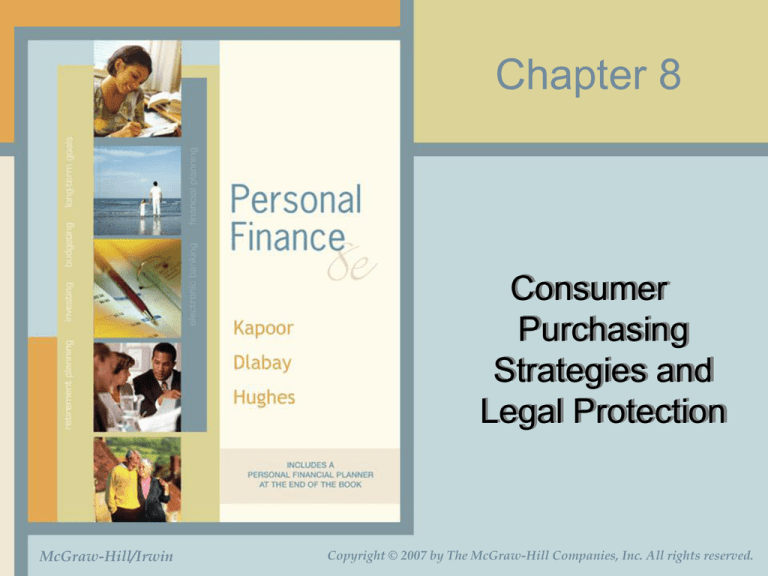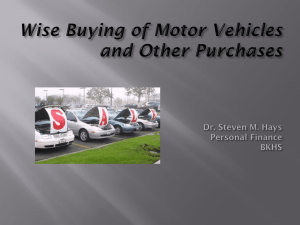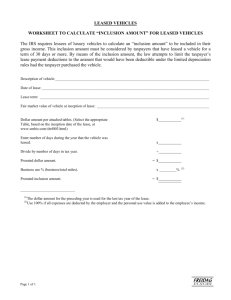
Chapter 8
Consumer
Purchasing
Strategies and
Legal Protection
McGraw-Hill/Irwin
Copyright © 2007 by The McGraw-Hill Companies, Inc. All rights reserved.
Financial Implications of
Purchasing Decisions
• Commonly overlooked trade-offs
when buying include…
Paying a higher price over time by using credit
to buy items you need now.
Buying unknown, possibly poor-quality brands,
that are less expensive.
Selecting brands that may be difficult to service
or repair.
Ordering by mail or online to save time and
money, but return or repair may be difficult.
Taking time and effort to comparison shop.
8-2
Social Factors
Economic Factors
Consumer prices
Interest rates
Lifestyle
Culture
Supply/demand
Brand name
Warranty
Product Quality
Attitudes
Ads
Media/Internet
Hobbies
Consumer
Buying
Influences
Peer
Tax rates
Govt. regs.
group
Personal Factors
Sex and age
Marital status
Occupation
Income
Education
Family size
Housing type
Ethnic group
Religion
8-3
Personal Consumer Protection
• To protect yourself as a consumer…
Deal with reputable companies.
Avoid signing contracts, documents you do not
understand.
Be cautious about offerings that seem too
good to be true - they probably are.
Compare the cost of buying on credit with the
cost of paying cash. Compare interest rates
the seller offers with other sources.
Avoid rushing to get a good deal.
8-4
Practical Purchasing Strategies
Timing purchases.
Be aware if the price varies with the time of the
year.
Store selection.
Choice of retailer depends on location, price,
product.
Cooperatives -non-profit organization; members
save money.
Comparison shopping of store and national
brands; avoid impulse buying (unplanned
purchasing).
Look for information on label and open dating.
8-5
Practical Purchasing Strategies
(continued)
Price comparison.
Unit pricing provides a standard of measurement.
Coupons (online: coolsavings.com; centsoff.com;
couponsurfer.com) and rebates (partial refund).
Convenience & ready-to-use products may mean higher
prices. Large is not always the best buy, and “Sale”
prices vary among stores.
• Evaluate warranties.
Full or limited express warranties, usually written.
Implied warranty of merchantability-fit for normal use.
• Service contracts -also called extended
“warranties.”
8-6
Purchasing a Car: A Research-Based
Approach - Phase 1: Preshopping Activities
Problem identification.
Information gathering.
Personal contacts.
Media information-television, websites
Independent testing organizations- Consumer
Reports
Government agencies.
Online Sources – www.edmunds.com,
www.caranddriver.com, www.autoweb.com
8-7
Phase 2: Evaluation of Alternatives
• Comparison shopping.
• Selecting vehicle options-convenience, appeal,
etc.
• Comparing used vehicles- www.carmax.com,
www.carfax.com
• Leasing an automobile
1) lower payments, small initial cash outlay
2) no ownership in vehicle
3) maximum # of miles/year; charged for extra miles.
4) know the capitalized cost of the lease, the money
factor, the monthly payment, number of payments,
and the residual value.
8-8
Phase 3: Determining Purchase Price
• Negotiation
Know necessary information about the product.
Deal with a person of authority to give you a lower
price or additional features.
Used-cars: Check newspaper ads, Kelly Blue Book
(www.kbb.com), www.edmunds.com
New cars: Set-price dealers, car-buying services
Compare financing alternatives.
Variety of lenders-some lenders may pre-approve
you.
Avoid being upside-down in your car.
Look for rebates or low-interest financing.
Consider the APR, total finance charge. Check out
www.bankrate.com
8-9
Phase 4: Postpurchase Activities
Lemon Laws.
Maintenance and ownership costs
Use the item correctly to have improved
performance and fewer repairs.
Investigate, evaluate and negotiate a
variety of servicing options.
Operation costs; fixed and variable
expenses.
Automobile servicing sources; dealers,
service stations, garages, Wal-Mart, etc.
8-10
The Used Car Inspection Process
• Outside the car.
• Inside the car.
• The engine.
Have a mechanic or technician of your choice
estimate the costs of potential repairs.
Odometer fraud.
• The road test.
8-11
Buying a Used Vehicle
• Sources of used vehicles.
New-car dealers.
Used-car dealers.
Private parties.
Auctions, used car superstores such as
CarMax, or online at sites such as
www.dealernet.com
Consumer protection for used car buyers.
FTC buyer’s guide in window.
Buy from a source that gives some
assurance of the vehicle’s reliability.
8-12
Used-Car Price Negotiation
• Price information sources
Edmund’s Used Car Prices or edmunds.com
NADA Official Used Car Guide.
Kelly Blue Book kbb.com
• The more new cars sold the
more used cars there are for
sale, keeping the prices down.
8-13
Gathering Information
• Sticker price - suggested retail price. It
includes the base price of the
vehicle plus accessories.
• Invoice price - dealers cost.
• Know the dealer’s cost by consulting...
Consumer Reports www.consumerreports.org
Edmund’s New Car Prices
www.Edmunds.com
• Buy in winter, early spring or end-ofmonth.
8-14
Selecting Options
• Mechanical devices.
Engine size, transmission, power steering,cruise
control, and antilock brakes.
• Comfort and convenience options.
Power seats, air conditioning.
Stereo systems, power locks.
• Aesthetic features.
Special paint.
Mag wheels.
• Service contract - look for costs and
exclusions.
8-15
Determining a Purchase Price
• Price bargaining - compare dealers.
• Set-price dealers.
• Car buying services.
Also called an auto broker.
$50-$200 over dealer’s cost.
• Online car buying
www.autobytel.com or autoadvisor.com .
• The sales agreement - specific details.
• Consumer protection for new-car buyers.
Warranties and lemon laws.
8-16
Financing an Automobile Purchase
• Financing sources.
Banks, credit unions, other financial
institutions, finance companies, or
dealer financing.
Get preapproved for a certain amount.
• Consider the length of the loan.
Upside down equity means that your
car is worth less that what you still owe
on your car loan.
• Check the APR and any rebates.
8-17
Leasing a Motor Vehicle
• Advantages.
Small cash outflow.
Lower monthly payments than buying.
Lease provides detailed records - helps if you
use your car for business purposes.
• Disadvantages.
No ownership interest.
Must meet requirements.
May have additional costs for extra mileage,
turning the car in early, or for certain repairs.
8-18
Types of Leases
• Closed-end.
You return the car at the end of the lease and pay
for any extra mileage or damage, but you are
committed for the full lease term.
• Open-end.
Easier to terminate the lease, but you have higher
lease payments and they may require you to pay
for the difference between the expected value of
the leased vehicle and the amount for which they
sell it.
• Single-payment - prepaid, discounted
lease.
8-19
Financial Aspects of Leasing
• Capitalized cost - the price of the vehicle.
Average buyer pays 92% of list, average
person who leases pays 96% of list.
• Money factor - interest rate.
• Monthly payment amount and number of
payments.
• Residual value - expected value of the vehicle
at the end of the lease. You may decide to
return, keep, or sell the vehicle. If the residual
value is less than market value, return it.
8-20
Financial Aspects of Leasing
(continued)
• Avoiding lease traps.
Not knowing the total cost of the agreement,
including the cost of the vehicle. Don’t just look
at the monthly payment.
Making a larger up-front payment than is
required, or paying unnecessary add-on costs.
Negotiating the monthly payment rather than
the cost of the vehicle.
Not having the value of any trade-in vehicle
reflected in the lease.
Signing a contract you don’t understand.
8-21
Costs of Operating a Car
• Fixed Costs.
Depreciation is the largest fixed cost.
Interest on loan.
Insurance.
License, registration and taxes.
• Variable Costs.
Gas and oil.
Tires.
Maintenance and repairs.
Parking and tolls.
8-22
Costs of Operating a Car
(continued)
• Keep good expense records.
• Follow the maintenance schedule in the
manual.
• Vehicle servicing options.
Car dealers.
Automobile repair shops.
Service stations.
Department and discount stores.
Specialty shops such as oil/lube, muffler,
transmission, and tire shops
Be alert for signs of fraud.
8-23
Steps in Resolving
Consumer Complaints
(continued)
Take legal action - options for
consumers...
Small claims court.
Class action suits.
Using a lawyer.
Other legal alternatives.
• Legal aid society.
• Prepaid legal services.
• Legal questions can be
researched at www.nolo.com.
8-25







